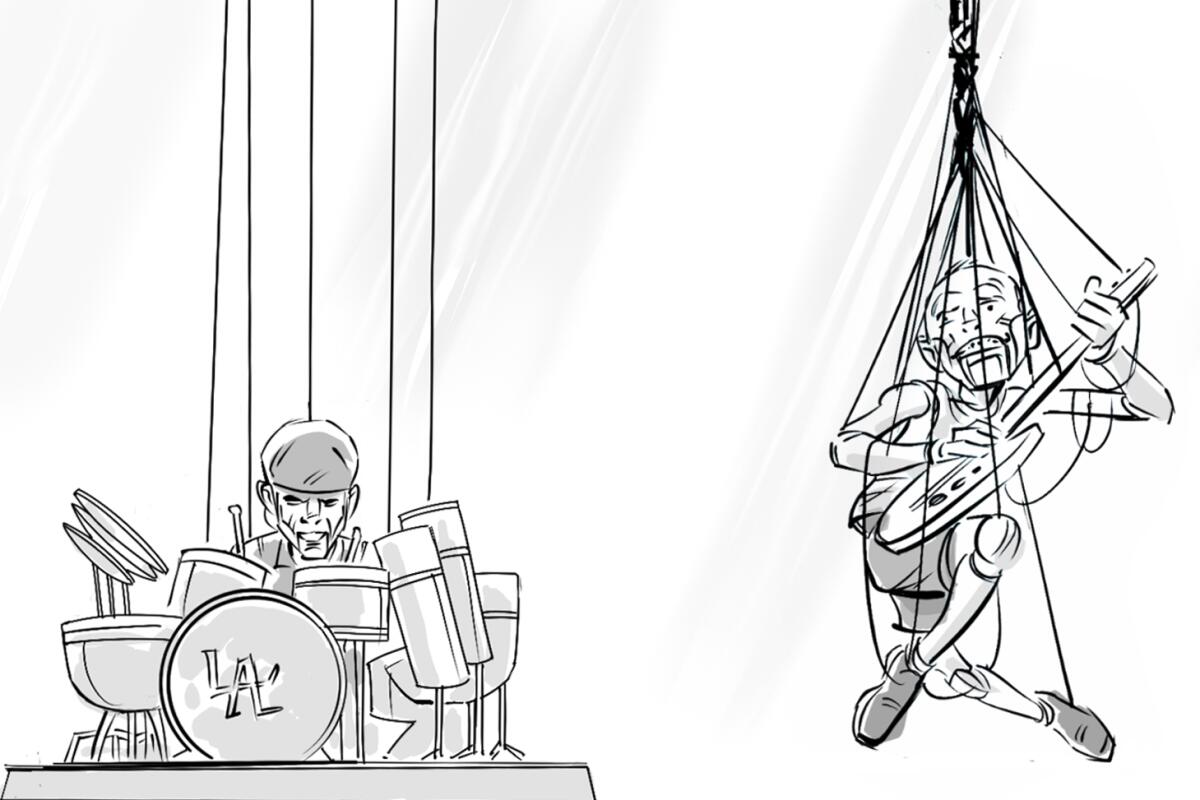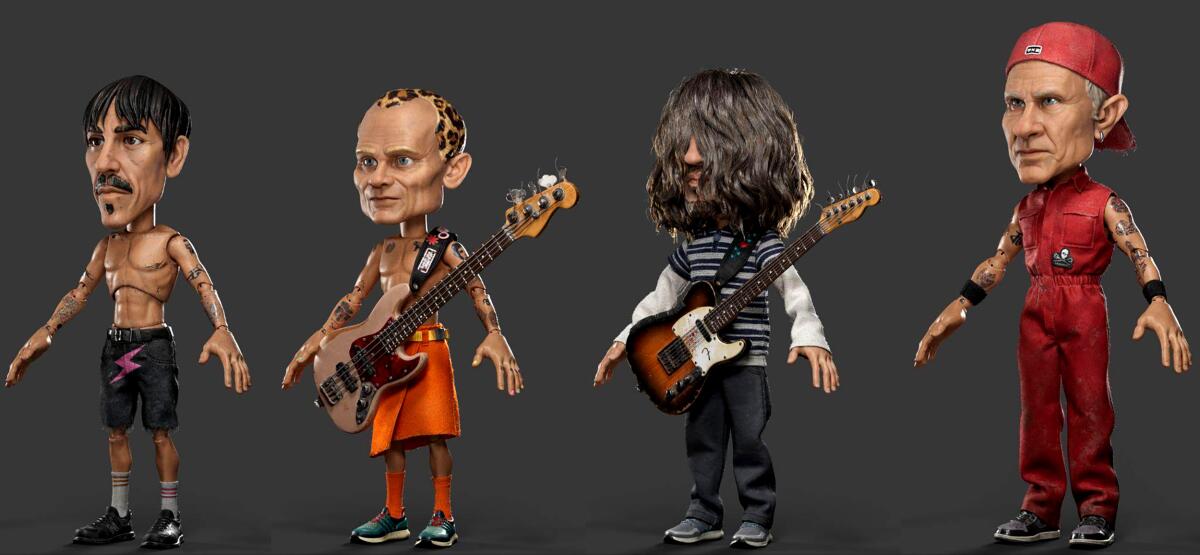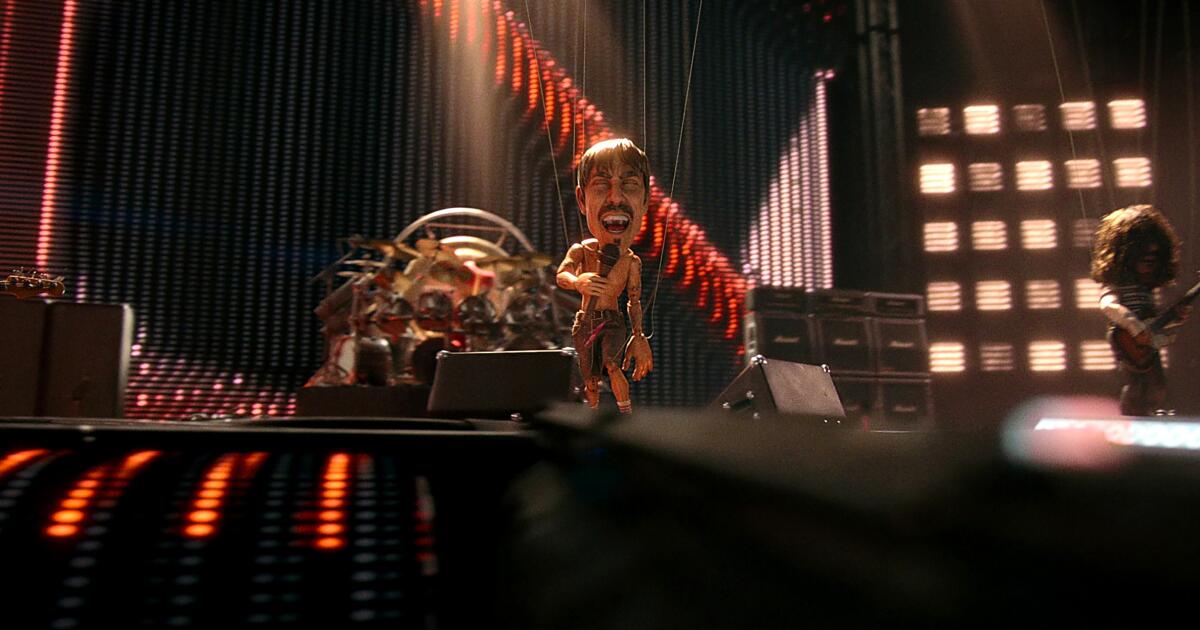Chad Smith remembers the night in 2003 when the Red Hot Chili Peppers played for an audience of 80,000 or so amid the rolling hills of the Irish countryside.
After a somewhat fallow period in the mid-’90s, the veteran Los Angeles alt-rock band resurged with 1999’s eight-times-platinum “Californication” and its 2002 follow-up, “By the Way,” which spawned the chart-topping single “Can’t Stop.” To mark the moment, the Chili Peppers brought a crew to document their performance at Slane Castle, where they headlined a full day of music that also included sets by Foo Fighters and Queens of the Stone Age, for an eventual concert movie.
“Everything’s filmed now, but back then it was a big shoot,” Smith, the band’s drummer, recently recalled. “You can get a little self-conscious. At the beginning, I f— something up — nothing nobody would know, but we would know — and Flea kind of looked at me,” he said of the Chili Peppers’ bassist. “We gave each other this ‘Oh s—’ look. We laughed it off, and I don’t think I thought about it after that because the crowd was so engaged. The energy was incredible.”
Twenty-two years later, the Chili Peppers are bringing that 2003 gig to screens again — only this time they’re string puppets.
“Can’t Stop” is director David Fincher’s re-creation of the band’s rendition of that tune at Slane Castle. Part of the just-released fourth season of the Emmy-winning Netflix anthology series “Love, Death + Robots,” the animated short film depicts the Chili Peppers — Smith, Flea, singer Anthony Kiedis and guitarist John Frusciante — as dangling marionettes onstage before a veritable sea of the same. As the band rides the song’s slinky punk-funk groove, we see Flea bust out some of his signature moves and Kiedis swipe a fan’s cellphone for a selfie; at one point, a group of women in the crowd even flash their breasts at the frontman.
The puppets aren’t real — the entire six-minute episode was computer-generated. But the way they move looks astoundingly lifelike, not least when one fan’s lighter accidentally sets another fan’s wires on fire.
So why did Fincher, the A-list filmmaker behind “Fight Club” and “The Social Network,” put his considerable resources to work to make “Can’t Stop”?
“A perfectly reasonable inquiry,” the director said with a laugh. “First and foremost, I’ll say I’ve always wanted a Flea bobblehead — it started with that. But really, you know, sometimes there’s just stuff you want to see.”

Why did David Fincher turn the Chili Peppers into puppets? “First and foremost, I’ll say I’ve always wanted a Flea bobblehead — it started with that. But really, you know, sometimes there’s just stuff you want to see.”
(Netflix)
Fincher, 62, grew up loving Gerry Anderson’s “Thunderbirds” series featuring his so-called Supermarionation style of puppetry enhanced by electronics. But the Chili Peppers project also represents a return to Fincher’s roots in music video: Before he made his feature debut with 1992’s “Alien 3,” he directed era-defining clips including Paula Abdul’s “Straight Up,” Madonna’s “Express Yourself” and “Vogue” and George Michael’s “Freedom! ’90.” (Fincher’s last big music video gig was Justin Timberlake’s “Suit & Tie” in 2013.) In addition to “Thunderbirds,” he wanted “Can’t Stop” to evoke the ’80s work of early MTV auteurs like Wayne Isham and Russell Mulcahy — “that throw 24 cameras at Duran Duran aesthetic,” as he put it.
Fincher said he knew his puppet concept would require “a band you can identify just from their movement,” which seems like a fair way to describe the Chili Peppers. He recalled first encountering the band around 1983 — “I think it was with Martha Davis at the Palladium?” he said — and was struck by a sense of mischief that reminded him of the “elfin villains” from the old Rankin/Bass TV specials.
“I feel like Finch got the spirit of me,” said Flea, 62, who’s known the director socially for years. The bassist remembered discussing “Can’t Stop” with Fincher at a mutual friend’s house before they shot it: “I was talking about how I still jump around onstage and my body still works really good. But I used to dive and do a somersault while I was playing bass — like dive onto my head. And now I’m scared to do it.” He laughed. “Some old man thing had happened where I’m scared to dive onto my face now. Finch went, ‘Well, Puppet Flea can do it.’”




Sketches of Red Hot Chili Peppers drummer Chad Smith and bassist Flea as puppets in Vol. 4 of Netflix’s “Love, Death + Robots.” (Netflix)
After doing a day of motion capture with the band at a studio in the Valley, Fincher and a crew of animators from Culver City’s Blur Studio spent about 13 months working on “Can’t Stop.” Fincher said the hard part was giving the marionettes a feeling of suspension.
“With the mo cap, you’re capturing the action of a character who has self-determination,” he said, referring to a human Chili Pepper, “then you’re applying that to an object that has no self-determination,” meaning a puppet controlled by an unseen handler. “It’s so much trickier than it looks. But that was kind of the fun, you know? I mean, not for me,” he added with a laugh.
Asked if the production involved any use of AI, Fincher said it didn’t. “It’s Blur — it’s a point of pride for them,” he said. But he also shrugged off the idea that that question has become a kind of purity test for filmmakers.

A digital rendering of the Chili Peppers as puppets.
(Netflix)
“For the next couple of months, maybe it’ll be an interesting sort of gotcha,” he said. “But I can’t imagine 10 years from now that people will have the same [view]. Nonlinear editing changed the world for about six weeks, and then we all took it for granted.
“I don’t look at it as necessarily cheating at this point,” he continued. “I think there are a lot of things that AI can do — matte edges and roto work and that kind of stuff. I don’t think that’s going to fundamentally ruin what is intimate and personal about filmmaking, which is that we’re playing dress-up and hoping not to be caught out.”
As he reportedly works on an English-language version of “Squid Game” and a sequel to Quentin Tarantino’s “Once Upon a Time … in Hollywood,” did making “Can’t Stop” lead Fincher to ponder the state of the music video now that MTV is no longer in the business of showcasing the form?
“Well, the audience that MTV aggregated — in retrospect, that was time and a place,” he said. “Remember, the Beatles were making music videos — they just called it ‘Help!’ There was no invention at all on MTV’s part.
“What I do miss about that — and I don’t think we’ll ever see it again — was that I was 22 years old and I would sketch on a napkin: This is kind of the idea of what we want to do. And four days later, $125,000 would be sent to the company that you were working with and you’d go off and make a video. You’d shoot the thing in a week, and then it would be on the air three weeks after that.
“You make a television commercial now and there’s quite literally 19 people in folding chairs, all with their own 100-inch monitor in the back. The world has changed.” He laughed.
“I started my professional career asking for forgiveness rather than permission, and it’s been very difficult to go the other direction.”
This story originally appeared on LA Times

